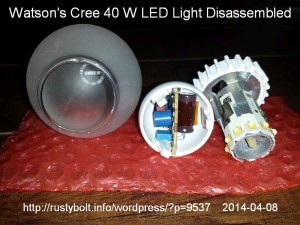I received my order of four LED lights made by Philips yesterday. They’re called SlimStyle, but they look like lollipops. It’s 2700 K warm white, 800 lumens and 10.5 watts. The model # is 9290002707. It’s also known as Philips 433227, but I don’t see that on the package.
I screwed it into a lamp and turned it on and it looks pretty good. The bulb has printing on it that says that it’s not supposed to be used in an enclosed fixture. I think that’s because it doesn’t have a heatsink in the base like most LED lights do. I will probably use them inside where they will stay relatively cool.
I stopped by Home Depot yesterday and these lollipop lights are now on the shelf. They weren’t there a week ago when I ordered them last week. They are not selling like hotcakes; I guess people don’t realize that spending $10 on a lightbulb can save them hundreds of dollars in the future. As soon as they buy the light bulb the sooner they start saving money. Instead they go by 4 packs of incandescent lights for a few dollars and waste several more dollars on electricity. That’s why they banned the sale of incandescent light bulbs. I talked to a guy I know who owns a restaurant. He had 55 of the PAR flood lights in his ceiling connected to dimmer switches. Last year I told him that if he replaced the lights with LED lights, he would save a lot of money. He tried some LED lights but they wouldn’t dim on his dimmer switches. The the Electric Company representatives came and replaced the lights with LED lights that work with the dimmer switch. He said he now saves $150 a month on his electric bill. I also said that because there’s less heat in the room he will save even more money and when it gets warm and the air conditioner starts to be on more. The restaurant is open 12 hours a day, 6 days a week, and even though it has skylights, the lights are on most of the time. So at $10 a lightbulb X 55 bulbs is $550. He’s already saved about half that and in a couple more months he’ll save the whole cost. Even if he had spent $20 a lightbulb a year or so ago, by now he would have saved more than the 1100 dollars it would have cost. The sooner you start using LED lights the sooner you start saving money and they pay for themselves quicker. Such a deal!
Here is a write-up in a blog about the Cree LED lights. They take a few apart to see how they are made. http://www.designingwithleds.com/inside-cree-led-bulb-family/
Yesterday I took a non-working 40 watt Cree LED lamp apart to see if it was the same as the ones in this blog. The globe is attached with glue that will come loose, but be careful. Even though the glass is coated with plastic, it could break.  Mine is a 40 watt equivalent. It looks almost the same as the ones in the blog.
Mine is a 40 watt equivalent. It looks almost the same as the ones in the blog.
Unfortunately the light has contacts that are spring loaded so that the parts can be snapped together. Once the lamp is assembled the contacts don’t move and over time I think the heat and oxidation cause the contacts to become intermittent. The light flickers every once in awhile, but not enough to be annoying. However the intermittent contact allows the power supply to lose its load for a very short time and then the voltages can climb to the extreme and that’s hard on the parts. Eventually the parts fail due to the stress. I think that’s what happened to this Cree lamp.
Here is an interesting website that deals with the electrical grid. http://fnetpublic.utk.edu
Really like your site. I’ve had the Phillips slim LED bulbs going for about a month now. Hope to convert all my bulbs over eventually. I like following your Joule thief circuits as well, I have several converted Malibu tiki lamps in my backyard.
Thanks for the kudos.